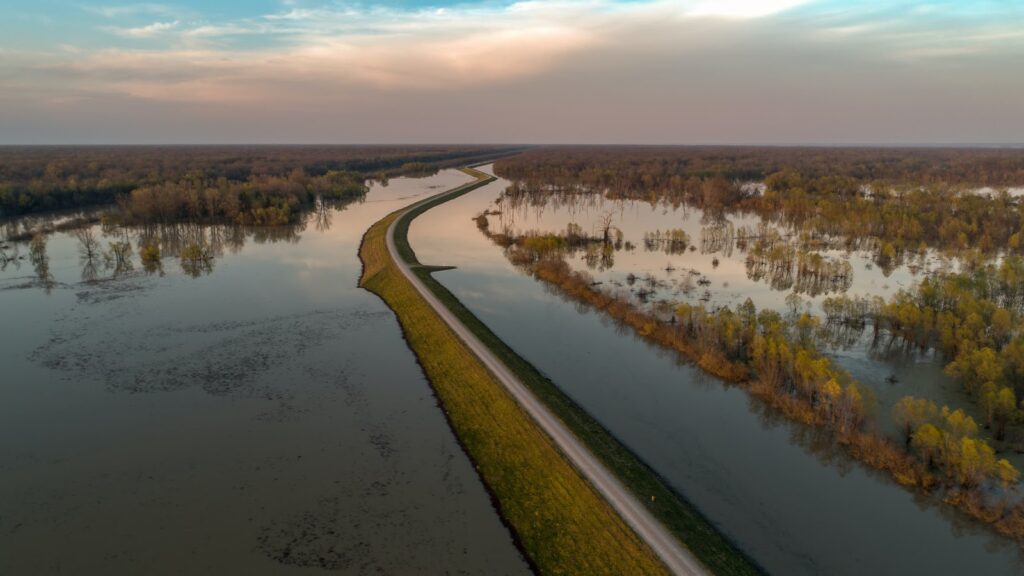How to Prevent a River from Flooding
Knowing how to prevent a river from flooding can save you from erosion, property damage, and more. Use TrapBags to create a flood control barrier on your river.

While the idea of preventing a raging river from overflowing may seem impossible, there are steps that individuals can take to reduce their risks and protect themselves in case of a flood.
What Causes River Flooding?
Heavy Rain
The most obvious cause of flooding in rivers and streams is heavy rainfall. This is what caused the recent flooding in Kentucky and Texas. Rivers and streams are natural flood drainage systems, but they can become overwhelmed.
One of the reasons that large portions of Kentucky are prone to river flooding is because much of the state is heavily mountainous. The rocky terrain is slow to absorb water, which means runoff quickly ends up in the river.
Melting Snow
Spring can be a precarious time of year for river flooding due to the amount of melting snow. It was a major factor in the flooding that hit Yellowstone National Park in June 2022.
Weather officials said Yellowstone had experienced unusually high precipitation during the winter that had led to snow becoming densely packed in some of the mountains. When an abrupt heat wave swept across the region it caused a large amount of snow to melt at once. It made the conditions just right for a major rainstorm to cause a severe flood—which is just what happened.
Ice Jams
During periods of quick and heavy thaws, large junks of ice that had been covering rivers, ponds, and lakes will periodically break off and float down a river. These ice jams can temporarily block the flow of the water, causing it to overflow onto the nearby banks. Since the way that ice breaks apart is rarely consistent, where and when an ice jam can occur is difficult to predict.
Dam Failures
Much of the nation’s water infrastructure is decades old, and there isn’t always enough money or oversight to keep them properly maintained and repaired. The dam failure that took place in Edenville, Michigan in 2020 is one such example. Residents who live downstream from a dam should always have a strategy to mitigate potential flood damage on their property.
The Damage Caused by River Flooding
The total damage caused by a river overflowing is almost impossible to fully quantify. There is the potential loss of life that should be everyone’s first priority to prevent. Then there are the homes and businesses that can be destroyed or significantly damaged by river flooding.
A severe flood can disrupt the environmental ecosystem and even change the landscape itself. The flooding in Yellowstone park may have permanently altered the route of a river and changed the fishing environment there. Some places that experience severe flooding aren’t able to fully financially recover from the economic impact even years later.
How to Prevent a River from Flooding
Preserve Natural Drainage
The natural landscape has a complex web of drainage systems that have been created over the course of long periods of time. When people develop an area, it is important that they understand the system so that any changes they make preserve as much of it as possible.
A watershed is a region where the landscape’s natural drainage system can be traced to a river, stream, lake, or other body of water. Every piece of land is part of a watershed and likely several smaller sub-watersheds. If portions of a watershed are blocked it becomes much more difficult for water to properly drain during heavy rainfall. This can lead to flooding in areas that may not have experienced it before.
Clean Regularly
Rivers collect countless numbers of items over the course of even a single year. Tree branches and trunks will fall into them, making a perfect spot for smaller items to catch and build up. While natural items will eventually decay and break apart, many pollutants will stay in a river for years or even decades. That’s why it’s important to keep pollution out of rivers and clean them as much as possible if items build up.
How to Manage River Flooding
While several river flood prevention methods can reduce the risk of flooding, they may not always be able to stop it completely. Having a plan to manage flooding when it occurs is crucial to protecting your home or business.
Build Up the River Bank
One of the biggest problems that can occur when a river overflows is erosion. Heavy floodwaters can break away large chunks of the river bank, which can present a long-term danger. That’s why it’s important to build up the river bank before a major flood occurs.
How to Build up a River Bank
An effective method of river bank building is to use TrapBags. They can create a custom foundation into which concrete, sand, or washed gravel can be poured. They can then act as a temporary or permanent way to stabilize a river bank in the face of flooding.
Create a Flood Control Barrier
The design and material of TrapBags allow them to create a strong barrier against river flooding. They are often used as temporary artificial levees to protect against rising water levels in major rivers. TrapBags can also be used to reinforce and improve natural levees when floodwaters are anticipated to go over them.
Why Choose TrapBag?
A TrapBag flood barrier is far more efficient than sandbags and much faster to deploy than other flood barriers. They have been used by mining companies to protect against mudslides, municipalities to keep flood waters away from critical infrastructure, and construction companies to make sure their job sites don’t become flooded.
Create a River Flood Management Strategy Today
The friendly staff at TrapBag would love to help you plan a flood control strategy to protect against river flooding. Tell us about your project and we’ll show you how TrapBag can help.
Meet the author
Get the Dirt Before the Flood Hits
Stay ahead of flooding, erosion, and disaster response challenges. The Dirt, TrapBag’s monthly newsletter, delivers field-tested tips, real-world case studies, and the latest in barrier technology straight to your inbox.

